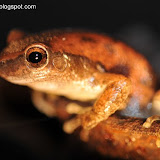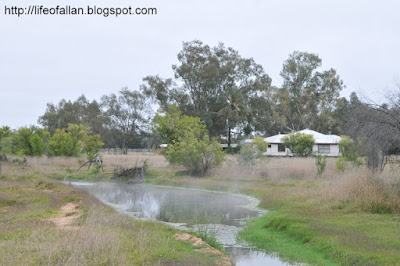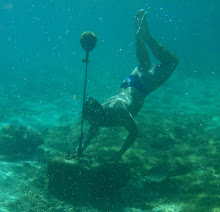
My last night at Bowra Station and I was out with the macro lens again. As always it was all happening, the creatures of the night very performing yet another fantastic show. To get an idea, while standing doing my cooking I literally had to be careful not to step on frogs that were busy jumping around trying to find a good spot for their nightly serenade performance.

A welcome abstraction from the frogs was a couple of geckos that had decided to call the shearer's quarters home, I believe they are Tree dtellas, Gehyra variegata. Old wooden buildings in the outback seems to host all kinds of exciting wildlife, the huntsman below had saved itself lots of work by catching dinner early.


The strange looking insect above gave me a bit of trouble, but it is probably a Mole Cricket Gryllotalpa brachyptera. Funny little thing that has the looks of a great digger - which it apparently is! - but it can also swim and fly, my first impression was that it looked a little front-heavy for such exercise, but nature will constantly surprise :-)


If you see frogs there will be snakes! - at least that is a saying I have heard plenty of times down here in Australia. I will say straight away that I did not see any snakes at all, I am sure they were there, but I well and truly missed them .. as it often happens with snakes. I had been slightly surprised when I realized that the campsite was directly up against the local swamp and with the amount of frogs around Bowra, and in particular around my tent, I must admit that I had checked the zip in my tent thoroughly before going to sleep. However, none of the other happy campers had seemed to worry so I did not want to be the "scared foreign tourist" and just adapted to the situation by performing the before mentioned extra check of the zip and my little "clean the boots before putting your feet in them"-routine in the morning. This second evening I had practically forgotten of the chance/risk of meeting a snake when a new Australian visitor arrived. After overlooking the campsite it was pretty clear that the shearer's quarters seemed much safer and I soon found myself in a weird situation trying to explain that "nah, you are unlike to see a snake and why should those snakes try to get into your tent?" and "they would not have placed the campsite here if it wasn't safe" .. arguments that I had used the night before convincing myself that it was all good :-D


After another great sleep, I was treated with the most fantastic sunrise. One of the first birds of the morning was a Major Mitchell's Cockatoo circling the campsite while making sure that no one could be in doubt that dawn was breaking. When the morning sun hits an agitated Major Mitchell's Cockatoo with raised crest, it is a great idea to have your camera ready, since this subdued colored bird becomes one of the most beautiful birds in Australia.


I had to leave Bowra, it was tempting to stick around for another morning, but when it comes to driving I very much like to have good time so that I can allow myself to stops along the way if something looks interesting - and after a little fueling trip to Cunnamulla the day before I was pretty sure that I would be seeing predator birds along those morning outback roads.


Indeed I did! Swarms of grasshoppers being exposed on the bitumen were easy pickings and had lured an excellent selection of large birds to land. Approaching slowly in the Magna seemed to be the best way of getting in close, but every move I made was being monitored and it was not appreciated when I rolled the window down and got the lens out.


I had another great encounter on the way home, approximately 50km south of Cunnamulla 2 Brolgas flew across the road - what a fantastic bird the Brolga is! Unfortunately the Magna had reached cruising speed and being alone in the car I felt it was to much of a job to control the car while shooting photos out the window. Luckily it is one of the birds, I have seen and taken photos of before.


I love driving in the outback, it is heaven compared to sitting in a queue in Sydney using 50 min doing the 18km to work knowing that you will have to spend the same amount of time going home later that day. You set the cruise control and keep an eye out for monitors and Brolgas and otherwise it is all easy ... except when trouble strikes!

There I was looking out for those monitors trying to cross the road when suddenly the road quality rapidly deteriorated. I remember sitting there thinking "this piece of road is pretty bad - they should do something about it". A quick glance in the mirror did however reveal that not only was the road bad, the Magna was belching out smoke from the right hand rear tire ... Time for a wheel change! Apart from spending a bit of time giving the Magna some new rubber, the trip back home went extremely well. I managed to make it all the way home to Coogee and all in all the long weekend escape to Bowra only cost me one extra day off from work - what a fantastic way to use a long weekend - Sitting here writing about it I get a very strong feeling of having to do something like that again.

All good! This is the last Bowra post from my 2010 trip, I will try to hurry and get the blog more up to date, however, generating "new material" for the blog has even higher priority.
Out of more than 2000 photos I have included 130 in my Bowra Station Picasa Album, a large part of them have been used in these Bowra Station blog posts, but feel free to follow the link below to see them all.
 |
| Bowra Station |
































